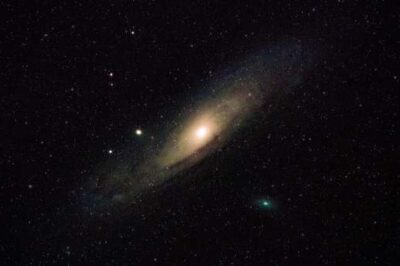Editor’s Note: To read the first part of this series, click here.
Author’s Note: This article is also available in video format on Timothy Alberino’s YouTube channel in English here and in Spanish here, and in audio format on The Alberino Analysis on Charisma Podcast Network.
In the previous episode of this series, we contemplated our place within the universe from a Christocentric perspective which places Christ at the center of all things and makes mankind a secondary character in the story of creation. In this episode, I would like for us to consider the other characters in the story, namely our extraterrestrial elder siblings, a race of beings ambiguously denominated as “angels” in the biblical narrative.
I am well aware that the term extraterrestrial is anathema in the worldview of many Christians, some of whom are no doubt already pounding away at their keyboards composing scathing comments that accuse me of having abandoned the faith, or worse, of being a satanic deceiver. But the visceral reaction to this word is entirely unwarranted. A simple definition will suffice to exorcise its imagined demons.
An extraterrestrial is a being whose provenance is not Planet Earth. Notice that I did not say residence. Provenance is where you come from. Residence is where you reside. It is entirely possible for beings of extraterrestrial provenance to be residing on Earth (as we shall see), a concept which necessitates the defining of another associated term—alien.
In the cosmological sense, an alien is a foreign being from an extraterrestrial world. However, generally speaking, any nonhuman being of advanced intelligence may be considered alien to the human species, regardless of its provenance. For example, if we should discover a race of nonhuman beings inhabiting the interior of our planet, or a parallel dimension, we would be accurate in describing them as aliens, even though we are essentially coinhabiting the same space.
With our terms thus defined, we may venture the question: Do extraterrestrials and/or aliens exist within the biblical paradigm?
The answer is, unequivocally, yes.
This should come as no surprise to students of the Scriptures. The biblical narrative unapologetically introduces us to a race of beings that are clearly alien (in every sense of the word), indisputably extraterrestrial and incalculably ancient. Indeed, these attributes are intentionally exemplified in one of the epithets used to describe them, the morning stars. The extraterrestrial provenance of the morning stars is plainly communicated to Job by the Maker himself:
Where were you when I laid the foundations of the earth? Declare, if you have understanding. Who has determined its measurements, if you know? Or who has stretched the line upon it? To what are its foundations fastened? Or who laid its cornerstone when the morning stars sang together, and all the sons of God shouted for joy? (Job 38:4-7).
We may deduce two logical conclusions from these verses: First, they are not referring to literal stars but the sentient sons of God, and second, these sons of God are older than the earth itself, since they were present to witness its primordial formation. The motif of the morning star in biblical parlance is meant to convey preexistence and preeminence. Like the planet Venus and other celestial luminaries visible at first light, the morning stars are children of the dawn. They constitute a race of heavenly beings that are both older and superior in nature than the human race—hence, the designation “elder race” which I employ in reference to them. The preexistence and preeminence of the elder race is manifest in the cosmology of the ancient Hebrews and presumed in the biblical narrative. In Psalm 8, for example, David writes:
When I consider Your heavens, the work of Your fingers, the moon and the stars, which You have established, what is man that You are mindful of him, and the son of man that You attend to him? For You have made him a little lower than the angels, and crowned him with glory and honor. You have given him dominion over the works of Your hands; You have put all things under his feet (Psalm 8:3-6).
The heavenly beings to whom David refers are the Elohim, members of the elder race who preexisted mankind and, in whose image, man was made. We will discuss this point at length in a later installment of this series. For now, let’s focus on the term most often used to describe them, angels.
Reference to angels in the biblical narrative is ambiguous by design. In consequence of this intentional ambiguity, many fanciful notions have been concocted regarding the nature and function of the elder race. The Church of Rome, for example, has developed focus on an entire angelic realm modeled in the Greco-Roman style, complete with the figures of heroic angels sculpted in marble and painted on sanctuary walls. The anatomical depictions of these heavenly beings are the product of pure fantasy. The great cathedrals of Europe are covered in the sensual physiques of angelic females adorned in feathery wings and the pedophilic portraits of chubby cherubim, usually depicted in the nude. Like the demigods of the Greco-Roman pantheon, the angels and saints of the Roman Catholic Church are revered as minor deities.
The situation is the much the same among certain protestant evangelicals who appeal to special revelation and religious superstition in the formulation of their own proprietary blends of angelology. These individuals have managed to make of angels a servile race of winged attendants whose sole purpose is to comfort and protect them or to do their bidding. Like the Catholic Church, they have assigned rank and duty to a florid variety of angelic beings inhabiting the fantasy land of their imaginations. Fortunately, most of their delusions can be dispelled with a cursory examination of the word angel.
Rendered as mal’ak in the Hebrew and angelos in the Greek, angel simply means “messenger; an envoy; one who is sent.” Hence, angel is a description of occupation rather than classification or kind. The word does not supply any insight into the provenance or nature of the person it denotes. Neither is it applied exclusively to heavenly beings. When functioning in the capacity of messengers and envoys, human beings are also referred to as angels in the biblical text. On the rare occasion that messengers of extraterrestrial provenance are dispatched to communicate with the inhabitants of Earth, they always have the appearance of men. So much do they resemble us—or rather, we resemble them—that the writer of Hebrews, while reminding the church not to neglect the entertainment of strangers, includes the curious addendum, “for thereby some have entertained angels unknowingly” (Heb. 13:2b). Quite contrary to Renaissance imagery, there are no occurrences of female angels recorded in the Scriptures. In fact, a feminine form of the Greek word angelos does not even exist. In addition, except in the context of prophetic iconography, or in the case of seraphim and cherubim (which are symbolic creatures subject to interpretation), angels are never depicted with wings. We do, however, often find them in possession of technology, such as vehicles of conveyance and weapons of war. It is also apparent that angels eat and drink, as they do so with both Abraham and Lot in Genesis 18-19.
The biblical narrative informs us that some angels deliver messages, some engage in warfare, some execute the judgment of God and some minister to the children of men, but we are never explicitly told who or what exactly they are. The question seems to be left for us to extrapolate—so let’s extrapolate: The angels of heaven have a spoken and written language; they keep records; they sing and compose music; they eat and drink; they possess, wield, and (assumedly) build technology; and they are the subjects of a kingdom, complete with a complex system of government and a standing army. These are the hallmarks of society and culture. It is therefore rational to conclude that the nonhuman angelic beings depicted in the Scriptures are the citizens of an advanced extraterrestrial civilization that predates our own.
Mankind did not invent civilization; he inherited it. The benchmarks of a civilized society—sophisticated bureaucracy, social hierarchy, a criminal justice system, refined spoken and written language, technological advancement, military organization and so forth—were already existent in the universe before Adam emerged from the earthen clay. In truth, we are the beneficiaries of the elder race, the recipients of their societal institutions and the coinheritors of their kingdom. We are also the coinheritors of their condemnation should we follow in their rebellion.
In summation, the nonhuman angelic beings depicted in the biblical narrative are unquestionably extraterrestrial in origin and ancient beyond reckoning. They are clearly members of an advanced civilization which is the predecessor and prototype of our own. And, as we will discover in the next lecture, although they are not human, they may be rightly considered our elder siblings.
If you wish to further explore the topics featured in this lecture, I encourage you to get my book Birthright: The Coming Posthuman Apocalypse and the Usurpation of Adam’s Dominion on Planet Earth. {eoa}
Known as a modern-day Indiana Jones, Timothy Alberino is a writer, explorer and filmmaker whose inquisitive mind and intrepid spirit have led him all over the earth in search of lost cities, lost civilizations, hidden treasures and legendary creatures. His appetite for adventure was manifest at the age of 18 when he dropped out of high school in Cleveland, Ohio, and moved to the Amazon jungle in Peru. Alberino is an accomplished autodidact and scholarly researcher. After years of rigorous study, he has garnered an expansive knowledge base that allows him to dissertate with authority on a wide variety of topics.
Read articles like this one and other Spirit-led content in our new platform, CHARISMA PLUS.







Leave a Comment
You must be logged in to post a comment.